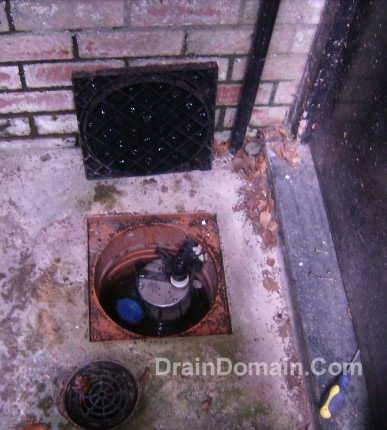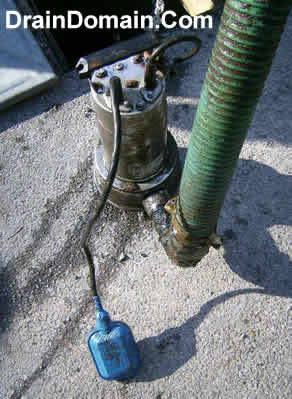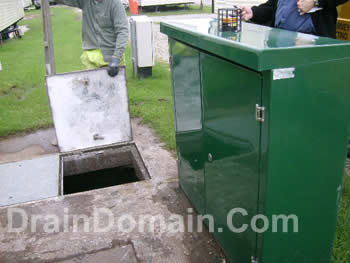Submersible Pump Systems
A submersible pump is a pump activated by a float switch, the pump is installed into a chamber and when the water level in the chamber rises to a set level the pump is activated, the water is then lifted to its outfall until the float switch rests in the base of the chamber and the pump automatically turns itself off.
 These pumps are used to lift water from one level to another and are often used in cellar and basement drainage, they are also used in land drainage to take the collected water to a suitable outfall and on the outlet of septic tanks to lift the waste water up into a soak-away situated in a more porous ground type. These pumps are used to lift water from one level to another and are often used in cellar and basement drainage, they are also used in land drainage to take the collected water to a suitable outfall and on the outlet of septic tanks to lift the waste water up into a soak-away situated in a more porous ground type.
The image to the right is an example of a pump installed at the base of some cellar steps, the original gully ran to a small soak-away which had failed and this pump was installed to lift any water that collected in the base of the stairwell up into a higher level storm system through the small bore pipe attached to the rear wall.
This particular pump would not see a lot of work as it is only intended to deal with any rain water that landed within the stairwell and pump chambers tend to be a bit deeper and wider so that a good volume of water can be lifted in one go, but this is a good example of how compact the pumps and chambers can be.
We would normally install a larger chamber so that when the pump is called upon a good volume of water is lifted in one go, you should also check that the pump has a non-return valve so that when the pump turns off any water held in the rising pipe work does not run straight back into the chamber.
Submersible Pumps Draining Groundwater In Basements
One thing you should bare in mind is that you do not want to be draining water lower then your house foundations as this can cause subsidence, if you are unsure of the extent and type of foundation you have consult a structural engineer or competent contractor.
The idea is to install a water tight chamber with an inlet set at the correct height which in the case of a cellar is somewhere between the cellar floor and the foundations which in many cases can be as little a 150mm between the two, this way you are not creating moving water below the foundations and you are not overworking the pump by needlessly drainage half the county.
Submersible Pump Chambers
 We tend to construct our own chambers from plastic or concrete manhole sections but you can buy prefabricated polypropylene, fibre glass and glass reinforced plastic chambers with the pump installed, all you then have to do is connect to the inlet and outlet and you are up and running, ideal for DIyers and installations in groundwater as you know the chamber will be a sealed unit. We tend to construct our own chambers from plastic or concrete manhole sections but you can buy prefabricated polypropylene, fibre glass and glass reinforced plastic chambers with the pump installed, all you then have to do is connect to the inlet and outlet and you are up and running, ideal for DIyers and installations in groundwater as you know the chamber will be a sealed unit.
Installing the Submersible Pump
There are several variations on these kind of pumps but they tend to have a fixed hinged arm or a flexible cable arm like the one in the image to the right, so you need to ensure that the arm can move freely without snagging or catching on the sides of the chamber or on other cables or lifting chains.
Lifting chains are used on deeper chambers so that when the pump fails or needs maintenance you can lift it out of the chamber without draining it first and it also stops you lifting the pump by its power feed cable and causing damage.
The chains also suspend the pump above the floor of the chamber where any heavy debris or silt will collect and be drawn into the pump itself, on smaller shallow chambers we sit the pump on a flag stone or brick base to achieve the same result.
Submersible Pump Size
The pumps come in many shapes and sizes and the one you require is obviously dependant on the volumes of water you are dealing with though Knowing this up front is not always that easy to work out, if you are replacing a pump you should try to get as much info off the defunct one as possible or failing that confirm the size of the outlet pipe and install a new unit that operates to the pipe capacity.
Most pump manufacturers have detailed information on pump size, volume and capacity on their web sites and many will be happy to give free advice on the phone, if you are undertaking a self building or replacing a large volume system they will often do a free site visit and appraisal as a loss leader to a sale.
Pump Maintenance & Running
The small bore pumps tend to be plugged into the mains electric but a circuit breaker should be used, if the pump has to be wired direct into the mains then you will need a qualified electrician who may well advise that the pump runs off its own board.
Pumps are very reliable these days and if the sump pump is prone to collecting silt it is prudent to clean it out once a year if possible, the life span of the pump is obviously dependant on the use it gets but on the smaller units when it packs up you may as well replace it for £150 to £200 rather than pay someone £55.00 an our to poke it with a screwdriver.
Once you get into the larger prefabricated units you will usually be offered a maintenance programme carried out by the supplier for an annual fee.
Foul Water Submersible Pumps
 Pumps are also used to lift waste water and solids and are often used in basements or where a property or properties are lower then the main sewer, these can be a small macerating unit taking a sole basement toilet, a prefabricated chamber and pump for a single property or a large rising main taking a full housing estate. Pumps are also used to lift waste water and solids and are often used in basements or where a property or properties are lower then the main sewer, these can be a small macerating unit taking a sole basement toilet, a prefabricated chamber and pump for a single property or a large rising main taking a full housing estate.
There are certain criteria to be met on units lifting all the foul waste from a property or properties into a main sewer, there has to be enough storage in the pump chamber for 24 hours of use in the event that the pump fails and on larger systems a back up pump is required within the chamber, a control box or panel is required above ground so that in the event of a pump failure a flashing light alerts residents.
DrainDomain Disclaimer Time - Needless to say if you are installing the pump yourself you should read the manufacturers recommendations and always use a qualified electrician when required.
|

 These pumps are used to lift water from one level to another and are often used in cellar and basement drainage, they are also used in land drainage to take the collected water to a suitable outfall and on the outlet of septic tanks to lift the waste water up into a soak-away situated in a more porous ground type.
These pumps are used to lift water from one level to another and are often used in cellar and basement drainage, they are also used in land drainage to take the collected water to a suitable outfall and on the outlet of septic tanks to lift the waste water up into a soak-away situated in a more porous ground type.  We tend to construct our own chambers from plastic or concrete manhole sections but you can buy prefabricated polypropylene, fibre glass and glass reinforced plastic chambers with the pump installed, all you then have to do is connect to the inlet and outlet and you are up and running, ideal for DIyers and installations in groundwater as you know the chamber will be a sealed unit.
We tend to construct our own chambers from plastic or concrete manhole sections but you can buy prefabricated polypropylene, fibre glass and glass reinforced plastic chambers with the pump installed, all you then have to do is connect to the inlet and outlet and you are up and running, ideal for DIyers and installations in groundwater as you know the chamber will be a sealed unit.  Pumps are also used to lift waste water and solids and are often used in basements or where a property or properties are lower then the main sewer, these can be a small macerating unit taking a sole basement toilet, a prefabricated chamber and pump for a single property or a large rising main taking a full housing estate.
Pumps are also used to lift waste water and solids and are often used in basements or where a property or properties are lower then the main sewer, these can be a small macerating unit taking a sole basement toilet, a prefabricated chamber and pump for a single property or a large rising main taking a full housing estate. 
